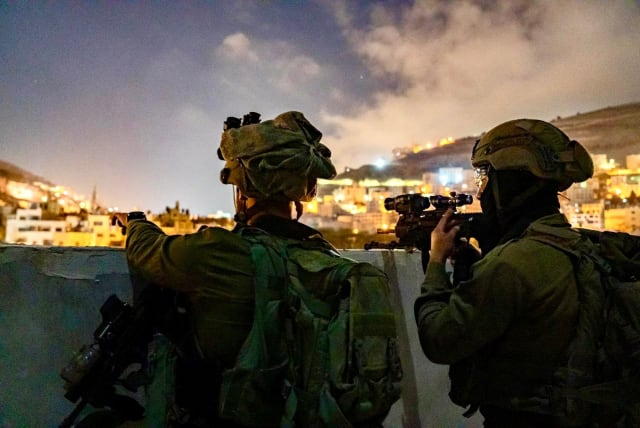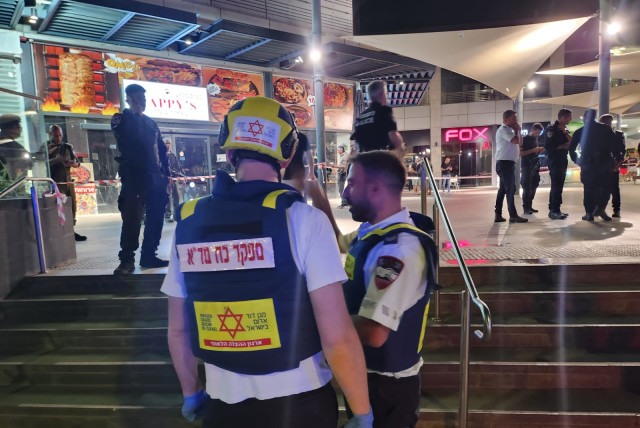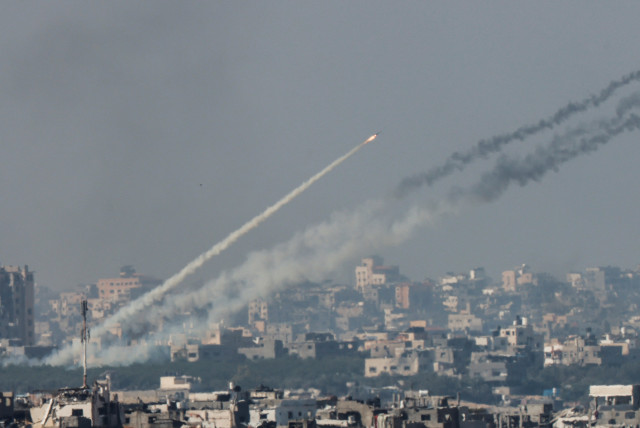
Three people were stabbed in a terror attack on Sunday night in Gan Yavne, near the according to Israeli media citing Magen David Adom (MDA).
The three people sustained serious wounds, according to MDA.

The police said the terrorist had been killed.
Police Spokesperson said Israel Police Commissioner Yaakov (Kobi) Shabtai was on his way to the scene.
"Following reports of a stabbing terror attack in the commercial area in Gan Yavne, a terrorist who arrived at the scene stabbed three civilians, injuring them moderately to severely (according to medical sources), using two knives with which he was armed," the police later said in a statement.
The police further stated a police officer and a municipal officer from Gan Yavne had heard cries for help and had found and neutralized the terrorist.
This is a developing story.
Go to the full article >>IDF spokesperson in Arabic exposed close cooperation between terror groups in concealing information and choosing launch areas far from houses of Hamas leadership, not Gazan citizens.
Avichai Adraee, the IDF spokesperson in Arabic, revealed on Saturday an official Hamas document recovered by Israeli soldiers in Gaza, which openly refers to Gazan casualties as a result of failed rocket launches, hiding this information from their constituency and blaming the deaths on Israel instead.
The revealed documents date back to 2020 and Operation Breaking Dawn (2022), and they were issued by Hamas’s al-Qassam Brigades and signed by high-ranking members of the militia. The findings showcase Hamas attempting to persuade members of other militias in the Gaza Strip, namely the al-Quds Brigades belonging to the Palestinian Islamic Jihad (PIJ), to take responsibility for the disastrous outcomes of failed rocket launches (referred to euphemistically as ‘local rockets’). The PIJ responded by requesting to conceal these failed launches and their repercussions to “support the image of the resistance.”
Another document showed a recommendation by Hamas to deny PIJ launching rockets specifically in the vicinity of houses belonging to the Hamas leadership fearing repetition of such events, yet no mention of preventing firing rockets near other Gazan residents’ houses was mentioned.
Lastly, Hamas reports were exposed featuring names of Gazan casualties as a result of failed launches, which were then recycled by Hamas in their outward reports of casualties, alleging they stemmed from Israeli airstrikes. In other words, Hamas counted casualties from PIJ failed rockets as casualties from Israeli attacks, proving yet again the lack of accuracy of their propaganda reporting.

These documents attest to the extent of Hamas’s control over and coordination with other militias in the Gaza Strip, dismissing the perception of some thought to be “unruly factions” acting from Gaza against Israel “on their own will,” and proving yet again that Hamas was, in fact, in control of these factions.
Go to the full article >>Turkish President Recep Tayyip Erdogan told Dutch Prime Minister Mark Rutte in a phone call on Sunday that Ankara would back a candidate to be NATO's new chief based on its expectations and needs, the Turkish presidency said.
Erdogan told outgoing premier Rutte that Turkey expected the new head of the security alliance to serve the needs and interests of allies regarding counter-terrorism and to take account of the sensitivities of non-European Union member allies, according to a statement from his office.
Go to the full article >>An "Israeli attack" was carried out in the Damascus area, activating Syrian air defense systems on Sunday night, according to Israeli news sources, citing Syrian media.
This is a developing story.
A mix of top Israeli and US officials have poured cold water on reports of being close to a multinational Arab force being able to manage internal security in Gaza and potentially also the West Bank.
Some of these officials also seemed to dismiss reports that Israel and the US were close to agreeing on a very tamped-down invasion of Rafah, which Washington would then support instead of criticizing.
Part of what was interesting about these dual reports was that, taken together as one full picture, they could have potentially solved a variety of Israel’s remaining largest problems as part of a grand series of bargains.
Israel wants to dismantle the remaining six Hamas battalions out of an original 24, four of which are in Rafah. But the problem was that the whole planet, and most importantly the US, not only opposes such an invasion due to concern for Palestinian civilians but there are countries who have even preemptively frozen arms purchases to convey to Jerusalem how serious their opposition is.
Go to the full article >>The IDF raid on Shifa, which began on March 18, has led to the arrest of hundreds of terrorists and the elimination of around 200 terrorists in clashes and gun battles. The terrorists moved back to the Shifa hospital over the last several months, assuming the hospital compound would be safe from a second Israeli raid after Israel had cleared and secured the area in November last year.
However, the second battle of Shifa has two sides to it. On the one hand, it’s true that it was a great success and netted hundreds of terrorists. On the other hand, some of these terrorists were aging terrorists who had been released in the past and should have been arrested or eliminated years ago. Therefore, the raid also sets a low bar on the kind of terrorists that are being eliminated. In essence, the raid tells us more about our own failures in not defeating Hamas in the past than it might tell us about the defeat of Hamas today.
Let me explain. One of the terrorists recently eliminated was Faid Dewik, a senior operative in Hamas’ intelligence unit. He carried out a shooting attack in 2002 and murdered four people. He was imprisoned and then released in the Shalit deal of 2011. He was involved in plotting attacks in the West Bank. At Shifa, he had fled to the maternity hospital, where he was eliminated. Another man with him was Zakariya Najeeb, another operative who focused on West Bank operations for Hamas. He was involved in the kidnapping and killing of IDF soldier Nachshon Wachsman in 1994. He was also released in the Shalit deal.
When we look at some of the terrorists being arrested or eliminated in Gaza, some of them were already detained in the past, and Israel has had the chance to eliminate them in the past. In essence, what we are witnessing is part of the toxic relationship between Israel and Hamas that has taken place over the last decades. As part of this story, Hamas was often able to survive and thrive by getting terrorists released. Israel would then arrest them again or have to fight them again.
Go to the full article >>The IDF announced on Sunday evening that Sgt.-Maj. Sivan Weil, 20, died from wounds suffered in southern Gaza battles throughout the weekend.
Weil, from Ra'anana, served in the Egoz commando unit. He was wounded on Friday.
Go to the full article >>https://www.youtube.com/watch?v=HzWqHPCX48o
Prime Minister Benjamin Netanyahu stressed that he is making the utmost effort to retrieve all the remaining hostages in Gaza, saying that he is "interested in succeeding, not appear as if I am only trying," during a Sunday press conference.
Netanyahu further commented on recent calls by hostages' families for him to step down as prime minister, saying that holding elections will take Israel "months back."
"The elections will paralyze Israel, and Hamas will be the first to congratulate [the new prime minister.]"
This is a developing story.
Go to the full article >>A report issued by Israel's Diaspora Ministry mapped the flow of donations and manpower from the Jewish Diaspora during the IDF's war on Hamas in the Gaza Strip.
The report tracked donations and support from the Jewish world from the outbreak of the Israel-Hamas war in October 2023 until February 2024.
The findings revealed that a total of NIS 5 billion (USD 1.41 billion) and approximately 60,000 volunteers flowed into Israel, signaling the broad mobilization of Diaspora Jews in many dimensions, including financial activities and on the public diplomacy front.
The Jewish Federations of North America (JFNA) raised approximately half the funds. Donations from independent federations were also raised, such as by the New York Federation, which contributed around 73 million dollars and is ranked among the highest among North American donors. Other large donation centers were the Chicago and Toronto federations, which raised 50 million dollars each.
Another method for collecting funds was through crowdfunding. The ministry found that approximately 91.5 million dollars were raised by crowdfunding alone.
Go to the full article >>



